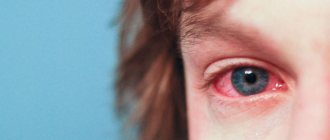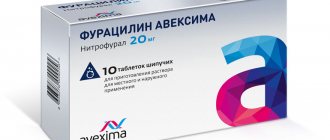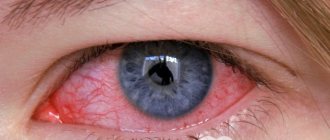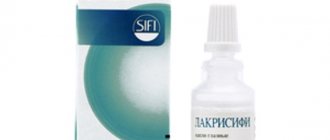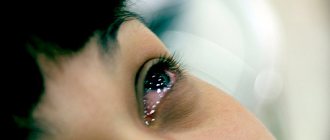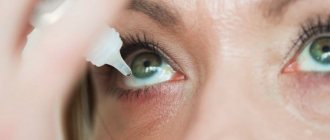With hemorrhagic conjunctivitis, extensive hemorrhages, or hemorrhages, appear in the eyes, which gives the pathology its name. Why hemorrhagic conjunctivitis occurs, how it differs and how it is treated, we will tell you in this article.
This disease belongs to infectious viral pathologies. It is very easy to become infected with hemorrhagic conjunctivitis through contact with another person or by using someone else’s hygiene items. The virus is also transmitted by airborne droplets, so you can get sick simply by traveling with an infectious person on public transport or in an elevator.
Due to the high contagiousness of a patient with hemorrhagic conjunctivitis, they are always isolated from other people. At a minimum, a sick family member will be moved to another room. With such a diagnosis, you cannot go to work or visit public places in order to prevent the epidemic process.
What is hemorrhagic conjunctivitis?
Hemorrhagic conjunctivitis is an acute infectious ophthalmological disease of viral etiology that can develop into a chronic form .
The problem is the development of an inflammatory process in the conjunctiva - the outer mucous membrane of the eye, covering the sclera and the inner surface of the eyelids.
The disease is seasonal and most often occurs in countries with warm climates .
After the accumulation of the virus at the site of primary reproduction, the pathogen enters the blood and quickly spreads throughout the body.
It penetrates into epithelial cells, muscles and nervous tissue, which is manifested in morphological changes in tissue and in the clinical picture of the disease.
Reference! The pathology received its name due to the presence of extensive hemorrhages - a distinctive feature that distinguishes this type of conjunctivitis from other infectious diseases.
Adenoviral conjunctivitis
This name hides two types of the disease, which quite often affect children aged 4 to 10 years. These are pharyngoconjunctival fever and epidemic keratoconjunctivitis, their causative agents are various types of adenoviruses, which can be infected in children's groups.
At an early stage, symptoms of pharyngoconjunctival fever include damage to the upper respiratory tract (inflammation of the nose and nasopharynx, tonsils), then they are added to conjunctival hyperemia, mucous discharge, swelling, the presence of films on the eyelids, pinpoint hemorrhages and the formation of follicles. Severe headache and increased body temperature are also noted. When treating this type of conjunctivitis in children, the ophthalmologist usually uses eye ointments: oxolinic, florenal or tebrofen ointment.
Nonspecific immunotherapy is used, which includes drugs of interferon/recombinant interferon alpha-2b or interferonogens (Poludan® or Actipol®). Treatment of concomitant diseases, which may include pharyngitis, rhinitis, tracheitis, bronchitis and otitis, is carried out by a pediatrician.
Epidemic keratoconjunctivitis is called a nosocomial infection because it mainly affects patients in medical institutions. Initially, symptoms of general malaise appear. Later, the conjunctiva swells, acquiring a pronounced red color, small follicles and pinpoint hemorrhages appear on the folds of the eyelids. About a week later, the disease subsides, but then re-exacerbates. It is accompanied by the appearance of pinpoint infiltrates (accumulations of blood cells) on the cornea, which are symptoms of keratitis. Cloudiness of the cornea appears in both eyes, and sometimes membranes form on the conjunctiva of the eyes. This disease can lead to serious complications.
Treatment of the disease is similar to the treatment of pharyngoconjunctival fever, but requires special attention at the stage of corneal inflammation. Usually at this stage, the ophthalmologist prescribes drugs that improve corneal regeneration:
- Drops "Taurine-AKOS", retinol acetate or palmitate, "Solcoseryl" or "Korneregel";
- Drops containing riboflavin, ascorbic acid and dextrose solution are also prepared ex tempore;
- Solution of cromoglycic acid or lodoxamide.
Symptoms
The disease is characterized by pronounced symptoms , so you can independently identify the problem at an early stage.
The main signs of hemorrhagic conjunctivitis are:
- increased lacrimation;
- swelling and inflammation of the eyelids;
- Pain in the eyes;
- severe itching and burning in the eyes;
- sensitivity to light stimuli;
- headache;
- redness of the conjunctiva;
- tingling in the corners of the eyes;
- mucous or purulent discharge;
- superficial keratitis;
- small follicular rashes on the eyelids;
- subconjunctival hemorrhage;
- sensation of a foreign object in the eye;
- increased body temperature;
- inflammation of the lymph nodes;
- decreased sensitivity of the cornea;
- general weakness.
Stay up to date! The incubation period of an infectious disease lasts from 12 to 48 hours.
At the very beginning of the development of the pathological process, the lesion is unilateral, however, after a few days the disease affects the second eye.
Symptoms of enteroviral conjunctivitis
As mentioned above, the incubation period lasts from two to ten days and begins with the sudden but acute onset of eye pain. Afterwards, lacrimation and photophobia appear, as well as a sensation of a foreign body inside the eye. A day later, the patient notices swelling and hyperemia of the conjunctiva, as well as hemorrhages and copious serous or serous-purulent discharge. If you do not contact a specialist in time, then after three days the process may spread to the other eye. In this case, it is possible that treatment, which usually takes no more than two weeks, will be delayed. Plus, the level of discomfort due to the disease will increase sharply.
Causes
The occurrence of hemorrhagic conjunctivitis is provoked by enterovirus-70 and Coxsackievirus A-24 , which belong to the picornavirus family.
The spread of the disease from an infected patient to a healthy person is through hygiene items, bedding and airborne droplets.
Anyone can become infected, regardless of age or gender, but people with weakened immune systems are most susceptible to infection.
It is worth noting! There are other predisposing factors for the development of the infectious process. Among them:
- the presence of chronic ophthalmological diseases;
- lack of personal hygiene;
- failure to comply with sanitary and hygienic requirements in public places.
Nonspecific catarrhal conjunctivitis of bacterial nature
These diseases are quite common in children and have a predominantly acute course. The causative agents are Staphylococcus aureus and Streptococcus. The disease is manifested by copious mucopurulent discharge, which dries on the eyelashes, severe swelling of the conjunctiva, its swelling and redness. In some cases, inflammation can also affect the cornea of the eye. How is this type of conjunctivitis treated in children? As a rule, the ophthalmologist prescribes drugs depending on the nature of the causative agent of the disease:
- In cases where the pathogen has not been identified, Miramistin is prescribed, along with which Sulfacetamide (drops) or one of the types of antibiotics is used: Ciprofloxacin (drops or ointment), erythromycin ointment, tetracycline ointment.
- If a staphylococcal pathogen is confirmed, treatment is supplemented with the prescription of Gentamicin (drops) or Tobramycin (ointment), or fusidic acid (drops).
- If the causative agent of a streptococcal nature is confirmed, Chloramphenicol is added to the main treatment (drops, the dosage is adjusted by an ophthalmologist).
The duration of medication use is determined by the doctor and depends on the effectiveness of the treatment. After acute symptoms have resolved, treatment of conjunctivitis in children is continued with glucocorticoids (GCS), for example, Dexamethasone (drops). If necessary, the doctor can prescribe combination medications that contain, in addition to GCS, an antibiotic - Neomycin, Dexamethasone, Polymyxin B.
With proper treatment, nonspecific catarrhal bacterial conjunctivitis in children goes away without complications.
Diagnostics
Diagnosis of enteroviral conjunctivitis is carried out by an ophthalmologist based on characteristic clinical symptoms and information on registered cases of infection .
Making a diagnosis usually does not cause any particular difficulties, however, an inexperienced doctor may confuse the disease with ARVI or influenza.
Therefore, the patient requires consultation with several specialists.
Note! In order to clarify the diagnosis, the following methods are additionally used:
- biological microscopy;
- taking scrapings from the conjunctiva;
- fluorescein angiography of blood vessels.
To determine the type of virus, cytological, serological and virological studies are also carried out.
How is enteroviral conjunctivitis diagnosed?
Typically, an ophthalmologist identifies the disease by a number of clinical forms that are characteristic of enteroviral conjunctivitis, especially during epidemic outbreaks. Diagnosis of sporadic enteroviral conjunctivitis is often difficult.
In addition to collecting anamnesis and examination, the specialist resorts to laboratory tests to confirm the diagnosis: mucus and secretions are collected. Serological studies are also carried out, for which paired sera are taken.
Treatment in adults and children
When diagnosing hemorrhagic conjunctivitis, the patient is immediately prescribed drug therapy .
To effectively treat the disease, the doctor may prescribe the following medications :
- antiviral – prevent the development of viral infection, affect the structure of the virus and disrupt its vital functions;
- antiseptic ointments – suppress the growth and reproduction of pathogenic microorganisms, destroy them, relieve pain and inflammation;
- corticosteroids – have a powerful anti-inflammatory effect and eliminate the symptomatic manifestations of the disease;
- non-steroidal anti-inflammatory drugs - reduce elevated body temperature, eliminate pain and relieve inflammation;
- antimicrobial eye drops - destroy cell membranes, having a detrimental effect on pathogens;
- vitamin and mineral complexes – enrich the body with useful substances, increase immunity and speed up recovery;
- antihistamines - used to relieve itching and burning.
Treatment of the enteroviral form of the disease is based on conservative measures, but if complications arise against the background of an infectious process, the patient may require surgical intervention .
You should know! Treatment with folk remedies is not carried out in this case.
Treatment methods
First of all, treatment involves initiating the outbreak and isolating it from other people. It is also necessary to isolate already infected patients and, if possible, people in contact with them. The therapy itself includes the use of antiviral drugs containing interferon. Additionally, a course of antihistamines and anti-inflammatory drugs is administered. For this purpose, corticosteroids can be used in low concentrations. To prevent complications from secondary bacterial infections, antimicrobial and antiseptic ointments are prescribed. The course of treatment is at least 14 days.
Hemorrhagic conjunctivitis should be treated as quickly as possible. In order to prevent the spread of the virus, contact persons may be prescribed medications containing ready-made interferon. Less commonly prescribed are drugs that stimulate the production of your own interferon, since their effect is longer. Detection of this pathology and its timely treatment help preserve vision and reduce the likelihood of complications.
We recommend reading an article about another type of conjunctivitis so as not to confuse the symptoms and treatment methods. Read about bacterial conjunctivitis.
To learn more about eye diseases and their treatment, use the convenient site search or ask a specialist a question.
Prevention
It is impossible to completely protect against conjunctivitis, however, every person can reduce the risk of its occurrence.
To prevent infection, it is necessary:
- Avoid contact with infected people.
- Do not touch your eyes with dirty hands.
- Wash your hands thoroughly with antibacterial soap after visiting public places.
- Use exclusively individual personal hygiene products.
- Rinse your eyes with clean water after swimming in a pond or pool without a protective mask.
- Take vitamin and mineral complexes.
- Avoid eye strain.
- When using eye drops, make sure that the tip of the bottle or pipette does not touch the mucous membrane of the eye.
- Women should only use personal cosmetics and not lend them to other people.
- Change bedding regularly.
- Ventilate the living space as often as possible .
- After interacting with an infected person, wash your eyes with an antiseptic solution .
- During an outbreak of viral diseases, avoid visiting public places or wear a medical mask.
- When wearing contact lenses, immerse them in a disinfectant solution immediately after removal.
- Treat any infectious diseases promptly.
- Lead a healthy and active lifestyle.
Treatment and prevention of viral conjunctivitis
Prevention of the disease consists of careful personal hygiene: hand washing, individual use of towels, cosmetics, care of contact lenses, and proper handling of medical instruments. In addition, it is worth strengthening your immune system.
Prevention of conjunctivitis
To treat viral conjunctivitis in adults and children, you need to see a doctor: he will find out which form you have and prescribe the necessary medications - drops, gels or ointments with an antiviral effect.
Herpetic conjunctivitis
The causative agent of the disease is the herpes simplex virus, which is infected in childhood. The symptoms are similar to those of pharyngoconjunctival fever: redness of the mucous membrane of the throat and nasopharynx, coughing, runny nose, to which later moderate redness and swelling of the mucous membrane of the eyes is added, with small follicles and pinpoint hemorrhages on the lower transitional fold of the eye and on the conjunctiva of the lower eyelid. Self-medication is unacceptable. It is imperative to show the child to a doctor who can determine the best way to treat such conjunctivitis in children.
Therapy in most cases is combined and helps both eliminate symptoms and combat the causative agent of the disease:
- Drops containing idoxuridine solution (“Oftan® Idu”).
- Ointments containing acyclovir (Virolex).
- Anti-inflammatory eye ointments: oxolinic, florenal ointment or tebrofen ointment.
- Interferon/recombinant interferon alpha-2b, or interferonogens (“Poludan®” or aminobenzoic acid “Aktipol®”).
- In order to restore the epithelium of the eye mucosa, Solcoseryl or Korneregel is used.
The frequency of use of drugs and dosage are determined by the doctor.
